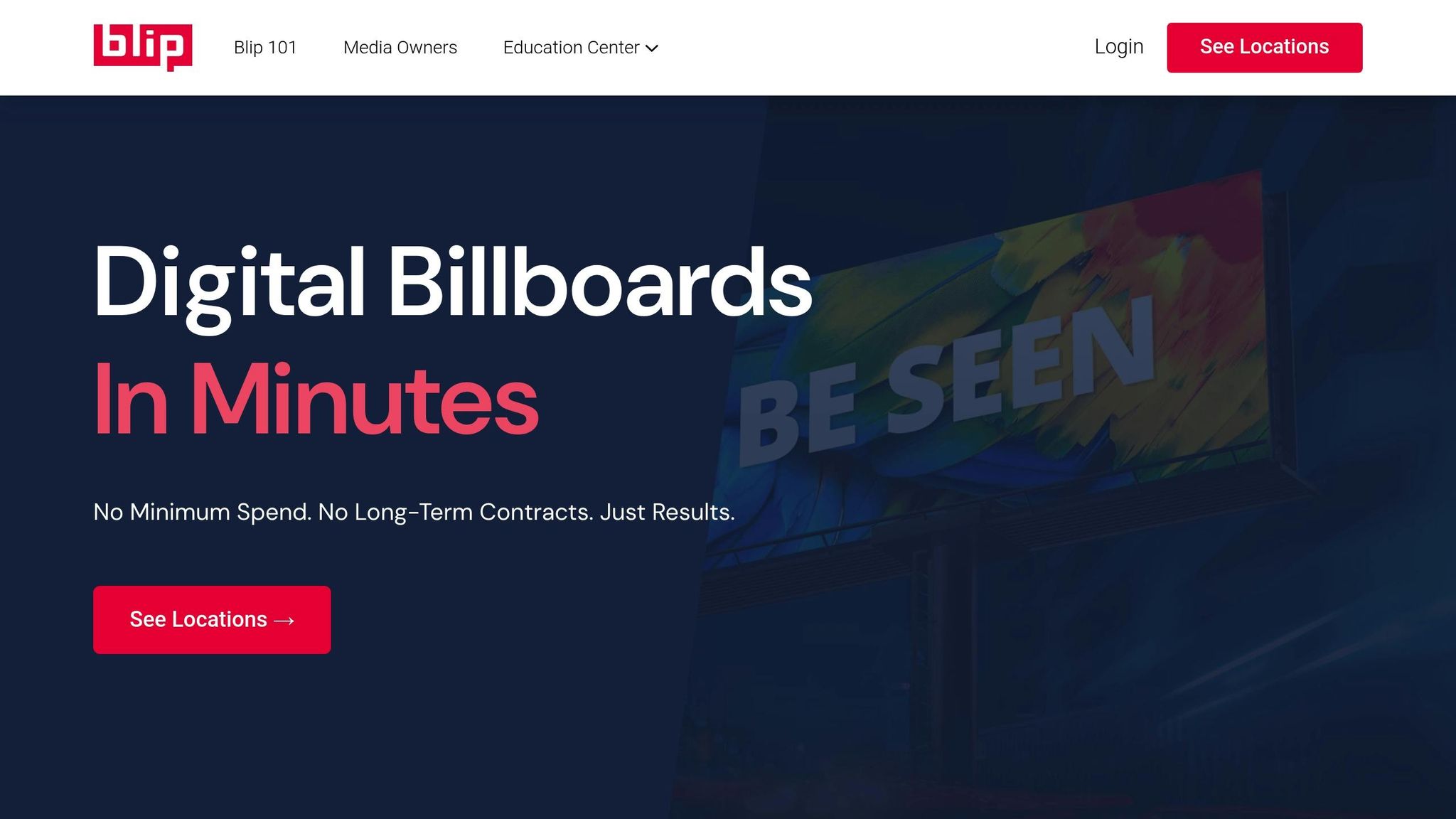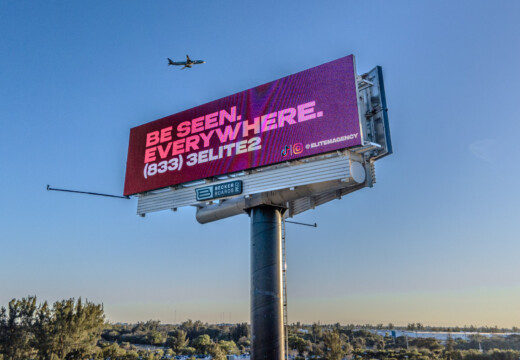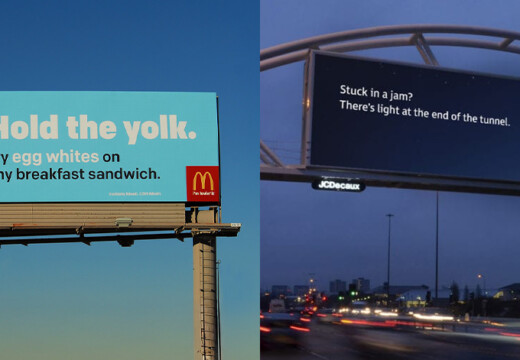Need a billboard permit? Here’s how to get started:
- Understand Billboard Permits: These ensure your billboard complies with safety, zoning, and community rules.
- Covers construction, zoning, safety, light pollution, and maintenance.
- Check Local Zoning Rules:
- Contact your local zoning office to find approved areas and restrictions.
- Review zoning maps and special district rules (e.g., historic or scenic areas).
- Prepare Required Documents:
- Include blueprints, safety/traffic studies, and an operations plan.
- Ensure documents are certified by licensed professionals.
- Submit Application:
- File online, in person, or by mail. Check fees and submission guidelines.
- Follow up regularly during the review process to avoid delays.
- Handle Issues:
- Quickly address feedback or required changes to your application.
Want a faster option? Use Blip. Skip permits and advertise instantly on pre-approved digital billboards starting at $20/day.
Whether you follow the traditional route or use Blip, this guide helps you navigate billboard advertising with ease.
Step 1: Check Local and State Rules
Review Zoning Regulations
- Get in touch with your local zoning or planning department to understand billboard rules in your area.
- Access the zoning map (either online or from their office) to identify where billboards are allowed or prohibited.
- Look into overlay districts, such as historic areas, scenic routes, or airport zones, as they may have additional restrictions.
Once you’ve reviewed the rules, move on to Step 2: Gather Required Documents.
How to Start a Billboard Advertising Business
Step 2: Gather Required Documents
Once you’ve confirmed the zoning regulations, it’s time to pull together the necessary paperwork. Here’s what you’ll need:
Blueprint and Construction Plans
Include detailed site plans, structural layouts, electrical schematics, and elevation drawings. These must be stamped by a licensed engineer to show they meet local building codes.
Safety and Traffic Studies
Provide analyses such as traffic impact reports, glare or lighting assessments, and safety reviews. These ensure the billboard won’t interfere with driver visibility or create hazards.
Billboard Operations Plan
Outline how the billboard will be managed. This should cover content scheduling, maintenance schedules, emergency protocols, and contact information for operators.
With these documents in hand, you’re ready to move on to Step 3: File Your Application.
sbb-itb-2e2e93f
Step 3: File Your Application
Submit your permit application following local guidelines to prevent any delays.
Submission Methods and Fees
You can submit your application in person, online, or by mail. Make sure to bring both the original documents and copies, upload PDFs if submitting online, or use certified mail for added security. Check your local permitting office’s website for the fee schedule – incorrect payments can hold up the review process.
Review Process Timeline
The review process generally involves these steps:
- Completeness Check: Ensures all required documents and information are included.
- Technical Review: Covers aspects like engineering, safety, and zoning.
- Public Notice: May be required in some cases.
- Final Decision and Permit Issuance
During the review, consider scheduling biweekly check-ins with the office to stay updated. Respond quickly if additional information is requested. Keep in mind, specialized reviews – like those by the DOT, FAA (for areas near airports), historic preservation boards, or other agencies – can add extra time.
Once your permit is approved, move on to Step 4 to address any conditions or changes that may be required.
Step 4: Handle Issues and Changes
Even with an approved application, follow-up requests can pop up. Here’s how to deal with them efficiently.
Common Permit Problems
- Missing or outdated engineer stamps on construction plans
- Incomplete traffic impact studies or related reports
- Zoning issues, like conflicts with overlay zones or setback rules
- Insufficient structural or safety calculations
How to Make Changes
- Submit updated documents within 10 business days of receiving feedback
- Arrange an in-person meeting with the permit office to go over revisions
- Get any necessary updated certifications from professionals
- Request a final review after completing all adjustments
Feeling overwhelmed? Check out how Blip can simplify the permit process for you.
Skip the Permit Process: Use Blip

Forget the hassle of permit applications – start advertising right away with Blip’s pre-approved billboard network.
What is Blip?
Blip eliminates the need for dealing with permits altogether. It offers instant access to thousands of pre-approved digital billboards across the U.S., with a pay-per-play model starting at just $20/day. You can set up a campaign in minutes, and your ads will go live within 1–3 days.
Why Choose Blip?
Here’s why Blip stands out:
- No permit delays: Get your ads live in days instead of waiting months.
- Full budget control: Spend as little or as much as you want – no minimums or contracts.
- Affordable pricing: Real-time bidding updates every 10 minutes to keep costs competitive.
Businesses using Blip have seen real results:
“It’s not a social media thing that you see on your phone. It’s not word-of-mouth. It’s big and bold and out there in public. I would say this is the first step of looking big and public.” – Chris Leslie, Founder, Leslie Lightcraft Co
With the permit process out of the way, you can focus on crafting and refining your campaign.
Conclusion: Quick Guide Summary
This guide walked you through zoning review, document preparation, application filing, and handling post-approval changes. If you’re looking for a quicker solution, check out the ‘Skip the Permit Process: Use Blip’ section above.
Blip offers a streamlined way to get your message out there. As Ray Bowens, Founder of Hashtag-Vape, shares:
“Billboards are one of the most impactful ways to advertise, and with Blip, you spend a fraction of what you would end up paying elsewhere.”
With Blip, you can access a network of digital billboards and keep your brand visible outdoors.
Whether you stick to the traditional route or opt for Blip to skip permits, both options can help elevate your brand based on your schedule and budget.


